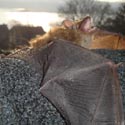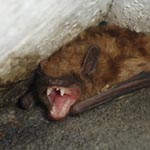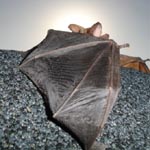Winter Bats in Mass. and Rhode Island
 Massachusetts and Rhode Island are home to two species of bats: the small brown bat and the large brown bat. Small brown bats are seasonal, arriving here in the spring and staying for the summer. When the cold weather arrives in the fall, the small browns will migrate to caves in the mid-Atlantic to spend the winter with millions of other bats. These small brown bats will leave the caves in the spring to migrate north to New England.
Massachusetts and Rhode Island are home to two species of bats: the small brown bat and the large brown bat. Small brown bats are seasonal, arriving here in the spring and staying for the summer. When the cold weather arrives in the fall, the small browns will migrate to caves in the mid-Atlantic to spend the winter with millions of other bats. These small brown bats will leave the caves in the spring to migrate north to New England.
Large brown bats in Massachusetts and Rhode Island are year-round residents. Large browns hibernate in attics and in other voids within a house during the winter months. These bats seem to prefer to hibernate in large Victorian and Colonial style houses in the greater Boston and Providence areas. We typically find them hibernating in the walls of such houses. These older houses were constructed with "balloon framing" methods. This means that the walls of the house are hollow with no fire blocking (walls in houses were not insulated back in the early 1900’s). From the attic, you could drop a golf ball behind a wall and it would land in the basement of the house. The bats are able to travel up and down these wall-voids from the attic to the basement.
Another way for bats to descend into the living space of a house is via the chimney. Just about every house in our area has a chimney, which stretches from the roof to the basement where it attaches to the heating system. Around the chimney there is a gap where the brick is cut through the framing of the house. Bats squeeze into this gap in the attic and drop down into the lower levels of the house.
On January 2nd 2006 I received a call from a man in Sudbury Massachusetts. He told me that he was beginning a home-improvement project in his kitchen on the first floor of his 1925 Victorian house. He began to tear down the sheetrock walls, and when he tore off the first piece he found three hibernating bats stuck to the slats inside of the wall-void. Why did these bats choose to drop down the walls from the attic?
My theory is that these bats drop down walls in the winter to find a comfortable temperature zone. The attic space in most houses is above the insulation, out of the "thermal envelope," and therefore gets very cold during winter months. Bats would much rather drop down a wall void and occupy an area with a warmer temperature than stay up in the attic space where it’s cold. I believe this is why most of our bats calls in winter are from older Victorian and Colonial style homes on the fringes of the big cities. Large brown bats seem to prefer to hibernate in this type of house because of the balloon-framing scenario that I described above. This is just a theory of mine, purely anecdotal.
Everyone will tell you that large brown bats in New England go into a deep sleep in the fall, hibernate all winter and wake in the spring. I respectfully disagree. More and more we’re getting calls for bats in the middle of winter. These winter bat calls are usually for bats in basements or other strange places. These bats are active in the dead of winter when they’re supposed to be hibernating. Sometimes these bats are only active within the house and other times they’re leaving the house at night and flying. If we get a period of warm weather in December, January or February, bats seem to be tricked into thinking it is spring. They will awake from their hibernation and fly at night. This happened during the first two weeks of January in both 2005 and 2006. In January 2006 we had one week in which the daytime temperature hit 50 degrees every day. During this period we received quite a few bats calls from all over Massachusetts and Rhode Island. I observed bats flying every night during this period. The Greater Boston Area had a large winter moth outbreak during the first two weeks of January 2006. The active bats were feeding on the winter moths. I’ll wrap things up by saying that large brown bat activity during winter months is largely tied into the temperature. It is not uncommon to have active bats during winter months in Massachusetts and Rhode Island.
These are photographs that i took on January 13th 2006 while conducting an inspection for a bat removal in Framingham MA. This large brown bat was roosting under a dormer on the roof of a three-story house. The daytime temperature hit 55 degrees that day and this bat thought that spring had arrived.
 The photograph to the left was taken on January 11th 2006 during an inspection for a bat infestation in Narragansett Rhode Island. You can clearly see the bat guano in the snow, which had a slightly different color than the normal guano seen during the warmer months. It was dull and slightly larger than normal. I believe this was due to the fact that the bats were eating nothing but winter moths, as this was the only food available to them.
The photograph to the left was taken on January 11th 2006 during an inspection for a bat infestation in Narragansett Rhode Island. You can clearly see the bat guano in the snow, which had a slightly different color than the normal guano seen during the warmer months. It was dull and slightly larger than normal. I believe this was due to the fact that the bats were eating nothing but winter moths, as this was the only food available to them.
In Massachusetts and Rhode Island, the presence of a bat anywhere in a house during the winter months usually indicates that a colony of hibernating large brown bats is present in the structure.
If you have a bat in your house or attic please visit our bat exclusions page for more information, or if you have any questions about a bat problem or would like to setup an appointment for an inspection you can contact us.


